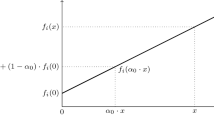Abstract
We propose a method to associate a coalitional interval game with each strategic game. The method is based on the lower and upper values of finite two-person zero-sum games. Associating with a strategic game a coalitional interval game we avoid having to take either a pessimistic or an optimistic approach to the problem. The paper makes two contributions to the literature: It provides a theoretical foundation for the study of coalitional interval games and it also provides, studies, and characterizes a natural method of associating coalitional interval games with strategic games.
Similar content being viewed by others
References
Bergantiños G., García-Jurado I. (1995), Estudio comparativo de diversas funciones características asociadas a un juego en forma normal. Investigaciones Económicas 19:127–138
Branzei R., Dimitrov D., Pickl S., Tijs S. (2004), How to cope with division problems under interval uncertainty of claims? International Journal of Uncertainty, Fuzziness and Knowledge-based Systems 12:191–200
Branzei R., Dimitrov D., Tijs S. (2003) Shapley-like values for interval bankruptcy games. Economics Bulletin 3:1–8
Carpente L., Casas-Méndez B., García-Jurado I., van den Nouweland A. (2005) Values for strategic games in which players cooperate. International Journal of Game Theory 33:397–419
Demange, G. and Wooders, M. (2005), Group Formation in Economics; Networks, Clubs, and Coalitions, Cambridge University Press.
Gerber, A. (2003), Coalition formation. in General NTU Games, in Dutta, B. and Jackson, M. (eds). Networks and Groups; Models of Strategic Formation. Springer-Verlag, 285–311.
Harsanyi J.C. (1963) A simplified bargaining model for the n-person cooperative game. International Economic Review 4:194–220
Myerson, R.B. (1991), Game Theory, Analysis of Conflict, Harvard University Press.
Ray D., Vohra R. (1999) A theory of endogenous coalition structures. Games and Economic Behavior 26:286–336
Von Neumann, J. and Morgenstern, O. (1944), Theory of games and economic behavior, Princeton University Press.
Yi S. (1997) Stable coalition structures with externalities. Games and Economic Behavior 20:201–237
Author information
Authors and Affiliations
Corresponding author
Rights and permissions
About this article
Cite this article
Carpente, L., Casas-Méndez, B., García-Jurado, I. et al. Coalitional Interval Games for Strategic Games in Which Players Cooperate. Theory Decis 65, 253–269 (2008). https://doi.org/10.1007/s11238-007-9091-x
Received:
Accepted:
Published:
Issue Date:
DOI: https://doi.org/10.1007/s11238-007-9091-x




